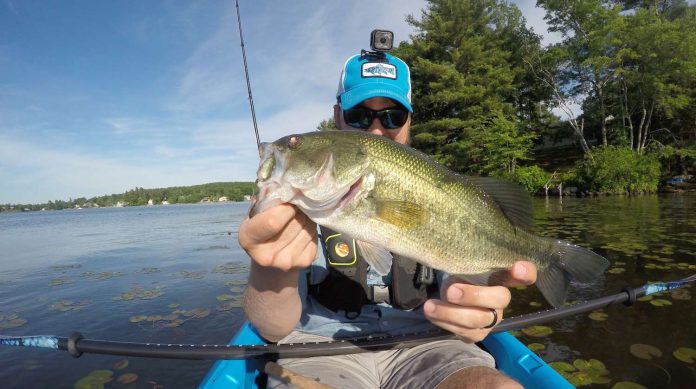Kayak fishing has changed so much over the past few years, but there’s one basic principle to follow when it comes to a good fishing kayak setup: what do you need to catch more fish?
You need other pieces of gear and accessories for safety and comfort, but since catching more fish is the driving force for getting a kayak in the first place, each item you rig on your kayak should help you land more fish.
The tools of setting up a grab-and-go kayak are simple, and it only takes some careful thought to lay out your boat exactly as you need it for your style of fishing and your local waters. Grab a drill, crank the tunes, pop open a frosty beverage, and start rigging. Consult the following principles when purchasing new gear, and learn everything you need to know when setting up a fishing kayak for freshwater.
Table of Contents
- Common Tools to Setup a Fishing Kayak
- The Perfect Grab-and-Go Freshwater Fishing Kayak Setup
- Grab the Best Fishing Kayak Paddle You Can
- Pick the Right PFD For Your Fishing Kayak Setup
- Mount High-Quality Electronics to Find Fish
- The Best Camera Gear For a Fishing Kayak Setup
- Store All of Your Tackle, Tools, and Gear Within Reach
- Bring Gear to Measure Your Fish on a Fishing Kayak
- A Good Fishing Kayak Setup Helps You Catch More Fish
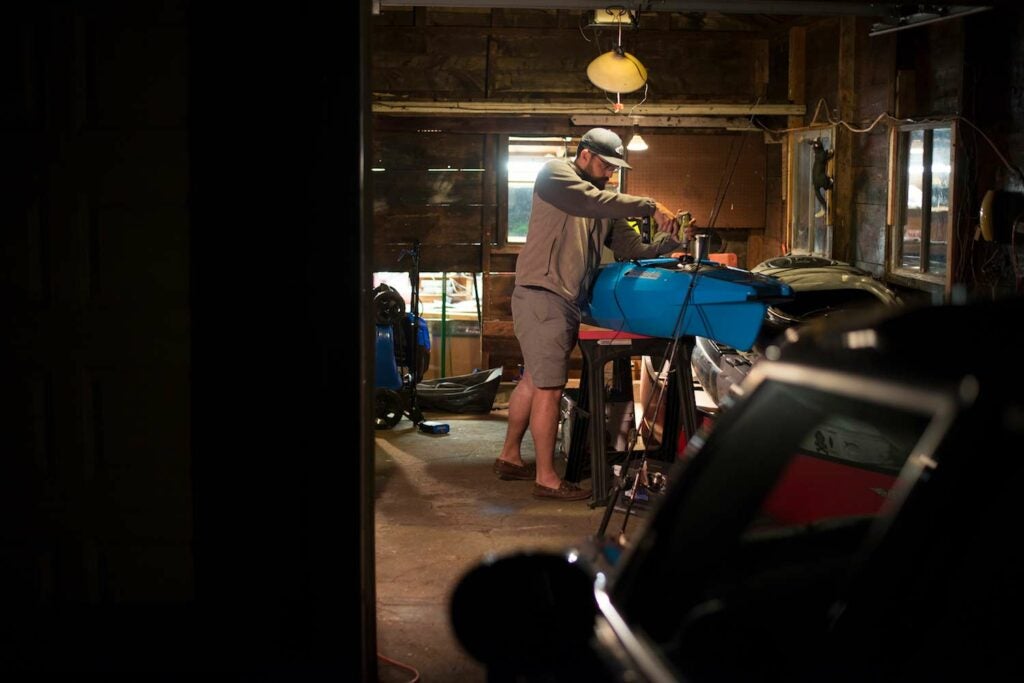
Common Tools to Setup a Fishing Kayak
You don’t always need every one of these tools, but when it’s time to get creative, it sure helps to have them on hand.
You’ll need:
- Cordless drill/Cordless impact gun
- Superglue
- Marine sealant
- Screwdriver
- Bungee cords or parachute cord
- Utility knife
- Shop lights
- 2 sawhorses
https://www.youtube.com/watch?v=AkIgnklX234/
The Bonafide EX123 is a great fishing kayak because its lightweight and easy to maneuver in freshwater. Amazon
The Perfect Grab-and-Go Freshwater Fishing Kayak Setup
The typical weekend plans mean your best windows for fishing will happen during the work week. After you factor in traffic, a quick bite to eat, and launching, that leaves about two hours to fish. Unlike setting up a saltwater fishing kayak, your freshwater setup should be about speed at the launch. The right kayak can’t create more time, but it can shave off crucial minutes at the launch to get you on the water faster. Sit-inside kayaks, or hybrids that blend the best of a fishing kayak and a canoe, are lightweight and easy to balance on your shoulder, making them the perfect option for a quick-to-launch boat.
At 67 pounds and with a price tag that’s cheaper than many of the current fishing kayaks available, (with the seat installed) the new Bonafide Kayaks EX123 is almost 20 pounds lighter than many other fishing kayaks. Bonafide designed the boat as the “SUV of kayaks,” which is why you can pack on tons of gear, up to 375 pounds, but it paddles more like a sports car. Within a few paddle strokes the boat picks up to 4 mph, without even trying. It does have the stability of a bigger boat, designed with Bonafide’s catamaran-style “HyCat hull,” which puts your feet below the water line to bring down your center of gravity. You can stand up to cast with ease.
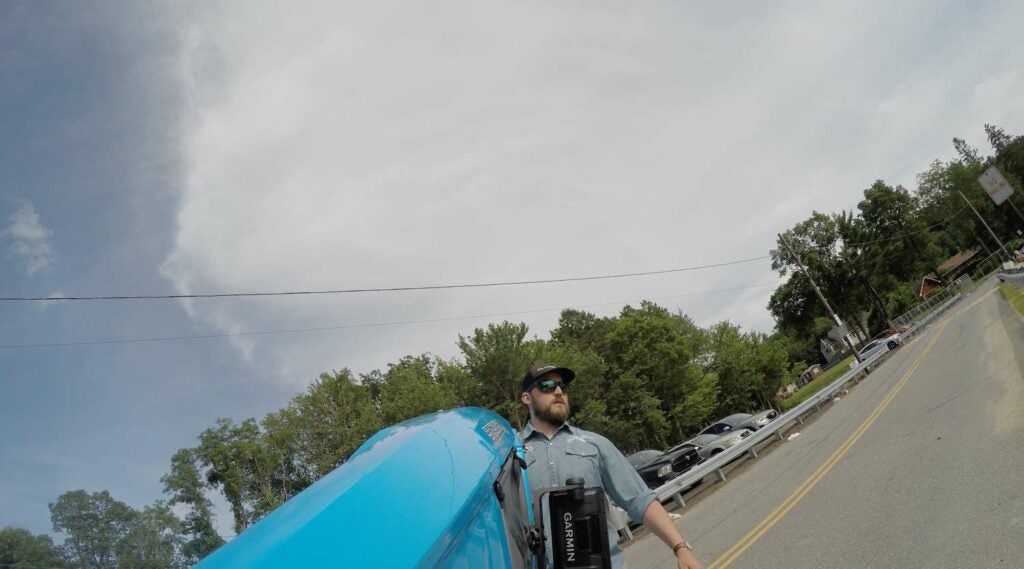
Before you start drilling into any new fishing kayak, take a seat inside and lay out all your gear where you think you’ll need it. Make sure nothing gets in the way of paddling, casting, landing fish, or taking photos of your catch. Use the features of the boat as much as you can, only adding accessory mounts where you will absolutely need them. Any piece of gear you add is another few minutes getting ready at the launch.
I barely made any changes to the EX123 fishing kayak. The only drilling I needed was to install the fishfinder and transducer, which I’ll cover further below. The rest of my gear I secured to the rear hatch, which Bonafide calls the HatchWell, and is a new spin on the traditional rear hatch design popular on many fishing kayak setups. A shallow tub in the top of the hatch and tie-down shock cord makes it easy to secure a kayak crate, and still gives you a ton of dry storage inside the hatch. Even though this makes an ideal grab-and-go kayak, the rear hatch is large enough to store a weeks worth of camping gear, clothing, and food––and keeps it all dry. Near the bow, a molded-in forward storage well with a hook-resistant, vinyl-coated cover adds another storage solution for items you may need on the water, like dry bags or rain gear.
So your essentials don’t go flying around inside the hull of your fishing kayak setup, Bonafide included a removable console at the front of the cockpit, which features an integrated “MiniTub” for keeping your phone, wallet, and keys dry and secure. The lid doubles as a selfie stand for taking photos and videos or for using a navigation app. The knobs that secure the console to the hull can be swapped out for any YakAttack mount, fishfinder displays, rod holders, and anything else you may need. Two flush-mount rod holders come standard behind the seat. The seat itself is comfortable, like sitting in a lawn chair, and has enough back support for all-day paddling.
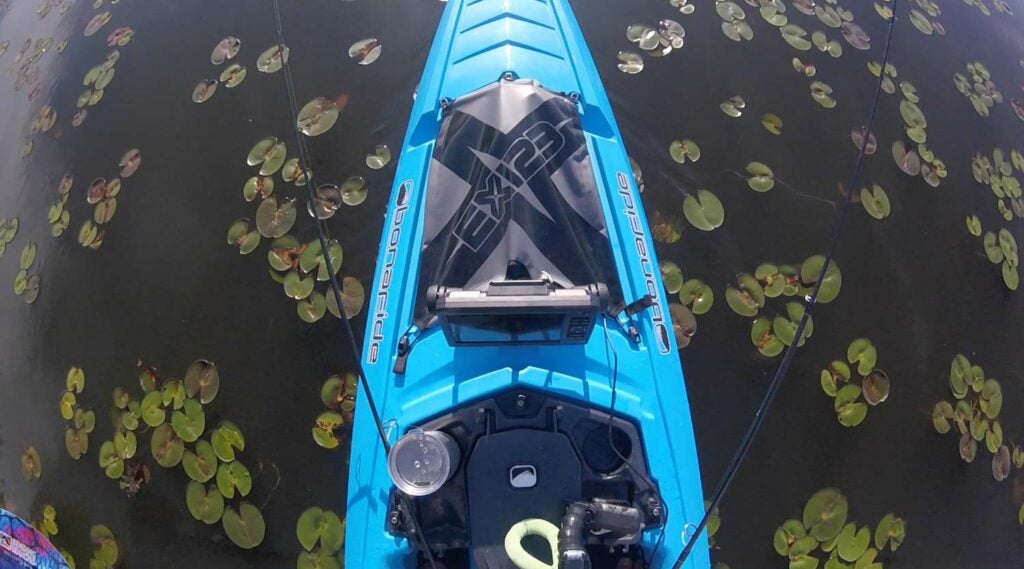
You can’t fish that honey-hole on the other side of the lake if you have no way of getting there, so invest in a solid kayak paddle if you can afford it. Your shoulders will thank you. Amazon
Grab the Best Paddle You Can
If you’re going to save money anywhere on your fishing kayak setup, don’t be cheap when it comes to a paddle. The paddle is your engine, so if you pair your sweet new kayak with a lousy paddle, you’re putting a lawnmower engine inside a hot rod. You want a paddle that’s lightweight, stiff, and, of course, one that looks as good as your boat.
There’s a reason the Bending Branches Angler Pro Snap kayak fishing paddle has won so many awards––this thing is nearly perfect. Remember that 4 mph speed I mentioned above? Even with a fast boat, if you skimp on a paddle, all of your energy is wasted in the flex of the blades, causing you to paddle twice as hard to reach the same speed. The Angler Pro Snap is feather-light and doesn’t flex at all when you’re pulling it through the water. That means every ounce of power is directly transferred to the water. The faster you can paddle your fishing kayak with ease, the more water you can cover and the more shots you get at fish.
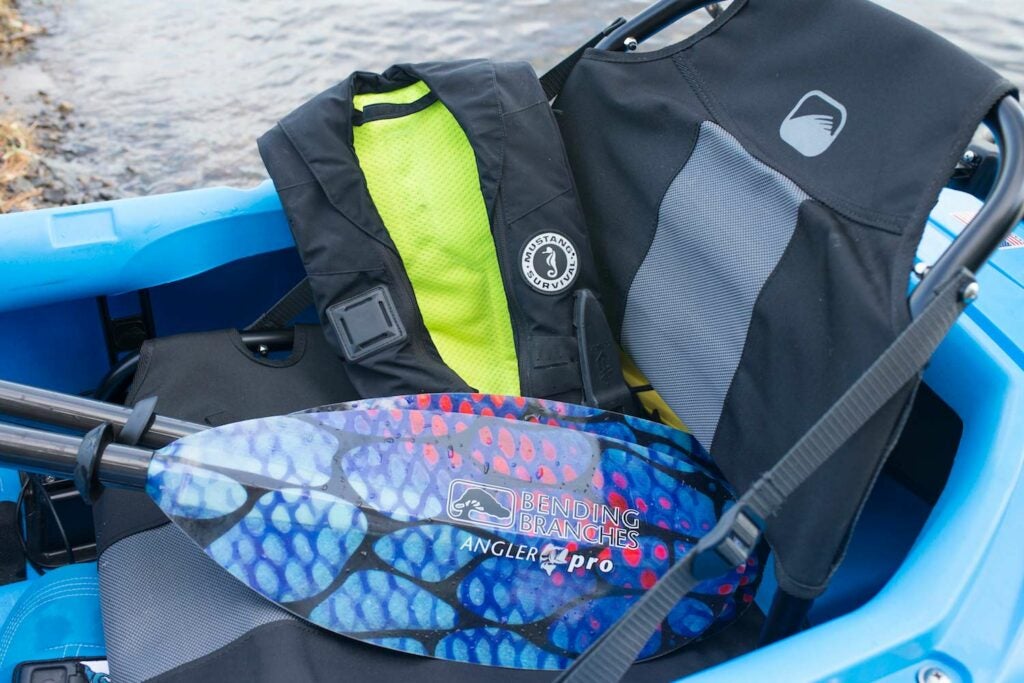
Since you need to look good on the water too, the Angler Pro is available in three patterns exclusive to Bending Branches: the high-visibility Dorado blade, the Raptor, or the Radiant. The Radiant color pattern matches the EX123 and looks great on the oversized blade. The carbon shaft feels light and balanced in the hands and, with many different lengths available, is long enough to paddle with standing up.
Pick the Right PFD For Your Fishing Kayak Setup
Your PFD, or personal flotation device, may not be part of your fishing kayak, but it’s one of the most important pieces of gear you can bring on the water. Some anglers refuse to wear their PFD, or only wear their PFD in certain situations, but if you get one that fits comfortably, you can wear it all day without even noticing it. When bass fishing from a kayak, I don’t expect to get wet at all, so to stay comfortable through the muggy dog days of summer, I reach for an inflatable PFD.

Even if you consider yourself a master swimmer, accidents do happen, so wear a personal floatation device (PFD) like the Mustang Survival Elite inflatable PFD, which is so lightweight and comfortable, you might forget you’re wearing it. Amazon
The Mustang Survival Elite 28 Inflatable PFD was designed specifically for Bassmasters Elite Series bass anglers. While you may not paddle at 60 mph, Mustang Survival designed the PFD in a wind tunnel so it doesn’t buffer at all at speed. The life vest is so light that you’ll hardly notice it’s there, and the flat back won’t interfere with your kayak’s seat like some other PFDs.
Mount High-Quality Electronics to Find Fish
When you’re setting up your boat and sitting inside it in your garage, pay special attention to where you place any electronics. Often, kayak anglers will rig their fishfinder too close to their seat. You may be able to see the screen more easily, but if it gets in the way every time you cast or paddle, you’ll get too frustrated for it to be any use. Instead of getting a smaller fishfinder that you can’t see unless it’s close, up your screen size and secure it to the deck just out of reach. Ninety percent of the time you don’t need to touch the screen, and when you do, the EX123 is stable enough to slide forward and chart out your next paddle.
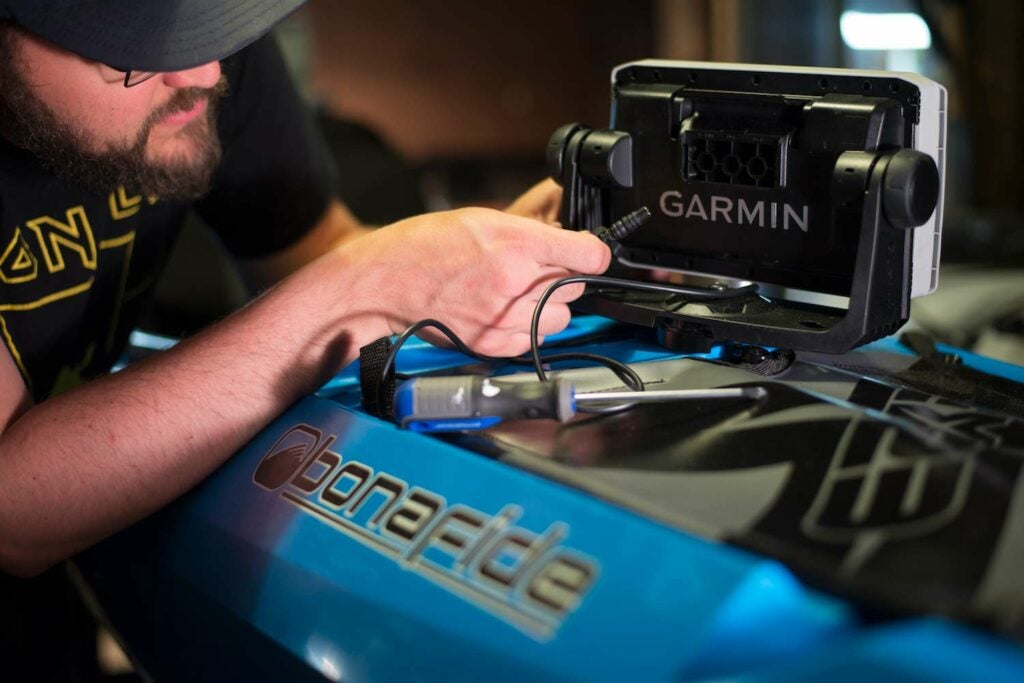
The unit features built-in Quickdraw Contours mapping software and it’s small and light enough that it won’t get in the way of other kayak fishing accessories you might have on board. Amazon
I mentioned drilling to install the fishfinder on the Bonafide Kayak. I could have installed it on top of the removable console, but I wanted to make sure it was out of the path of my paddle. The GARMIN ECHOMAP Plus 63cv with a six-inch screen is big enough that I could see the navigation charts or sonar screens easily, even when leaning back or paddling. This unit has everything you could need to find fish: Garmin CHIRP traditional sonar, CHIRP ClearVü views, LakeVü g3 maps with integrated Navionics® data up to one-inch contours, and the ability to create waypoints on your local waters.
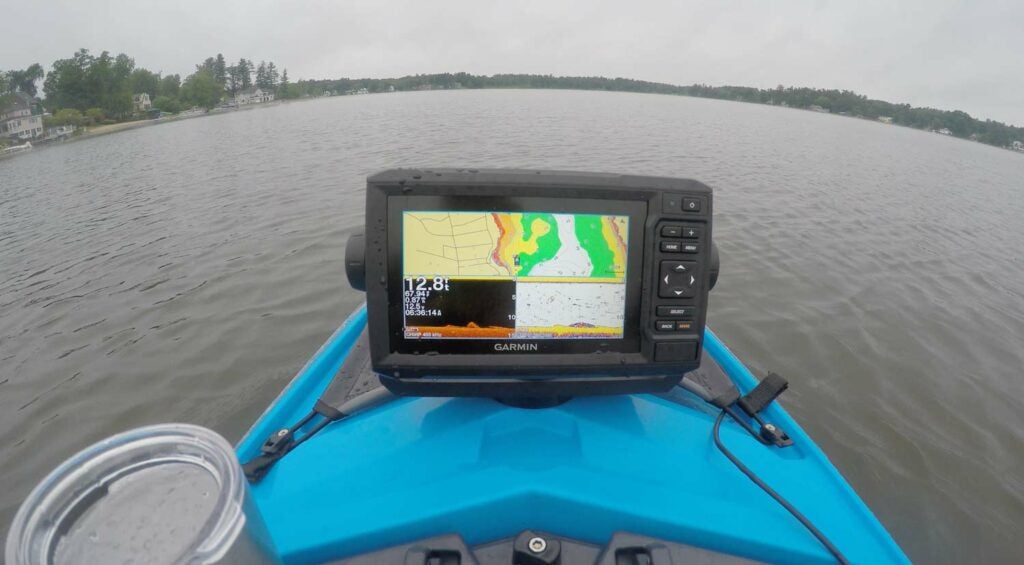
The included rotating mount was perfect for mounting on the deck of the kayak. It even tilts up and down, so I can keep looking for inside turns on the nav charts or spot fish passing underneath when I’m standing up. You can customize your screen however you like to fish, and switching between modes is easy enough to do in between paddle strokes.
The Best Camera Gear For a Fishing Kayak Setup
Obviously you’ll want a camera to show off your catch. You could drill a camera mount to the top of your kayak, or place an action camera on a camera pole inside your flush mount rod holders, but I don’t do either of those. Instead, I want a camera that’s dynamic that can move where I need it to get the shot. I basically want another camera man on the boat filming me like I’m in the Bassmasters Elite Series. That’s where the ActionHat comes in.
If you’re the type of angler that likes to film your own adventures, you can use the ActionHat DIY kit to turn your go-to hat into a camera holder. Amazon
(Full disclosure, the inventor of the ActionHat, Rex DeGuzman, is a friend. Still, I haven’t stopped using the ActionHat on my fishing kayak since I first tried it only because it really works.)
The ActionHat DIY kit, can turn your favorite hat into a camera mount that’s comfortable to wear, easy to use, and even floats when you drop it into the drink. Instead of wrangling with a GoPro strap one-handed, stretching it across your face and praying the fish stays on the end of your line, the ActionHat is as easy to put on as, well, a hat. I pair it with a GoPro Session so turning on the camera takes a single press of a button, which I can do while putting it on. Within seconds of hooking up, I’m recording. Once the fish is landed, simply place the hat on the deck of your boat to get your hero shot with the fish.
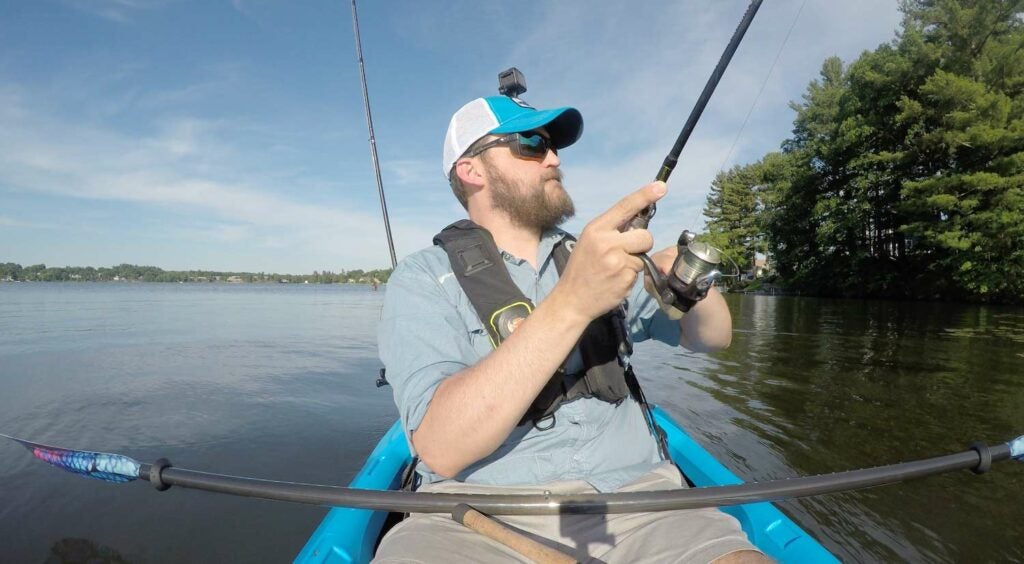
While action cameras are great for recording your catch, you need to actually catch the fish first. Amazon
Have you ever come across something on your fishfinder that you wanted to investigate? Instead of guessing, take a look with the Aqua-Vu Micro Stealth 4.3 camera. Many ice fishermen use this camera for taking a peek inside their holes in the ice, but a closer look at a piece of structure beneath your kayak can provide valuable insight into how fish are oriented, or how active they are, which can help you put together the puzzle of what lure to tie on.
Aqua-Vu offers a kayak mount, but I placed the camera right inside the removable console on the Bonafide Kayaks EX123. When I came across an image on the fishfinder that I wanted to explore a little closer, I dropped the camera on the end of a power cord down to the bottom and turned on the included light to take a closer look. I watched fish circle a mangled shopping cart and found that a few were big enough to chase with a spider jig. When I was done, I reeled the camera back in with the reel on the back of the monitor and packed it away in seconds.
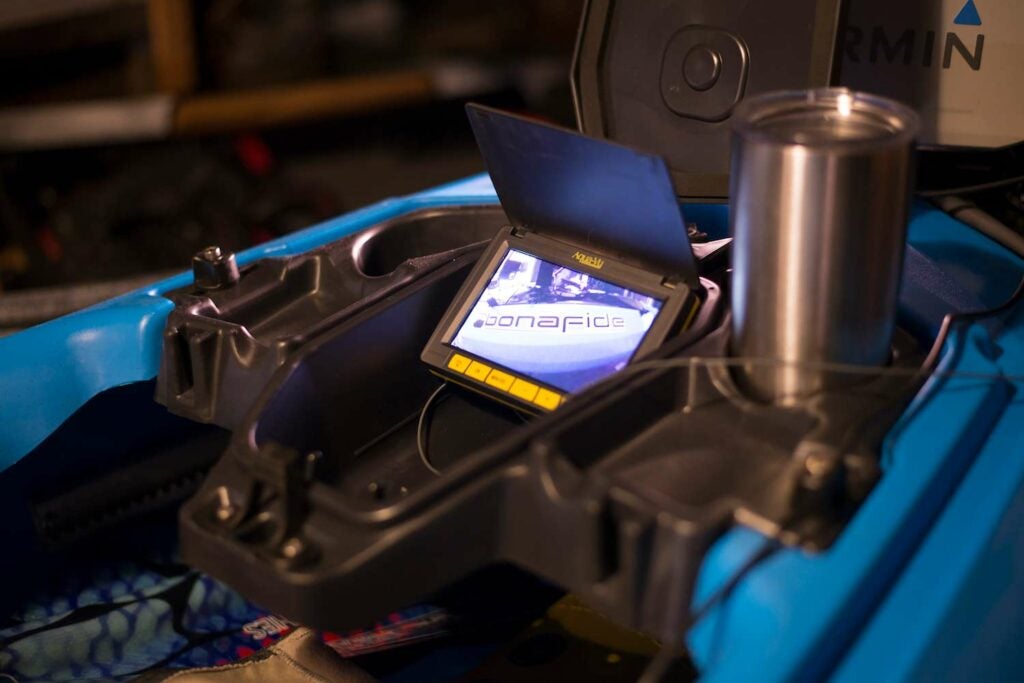
Store All of Your Tackle, Tools, and Gear Within Reach
Most importantly, where do you put your lures, leader, and other tackle? Finding a good kayak crate that can last season after season is tough, as you’re constantly going in and out of the crate throughout your day on the water. That wear adds up over time, especially when you’re dealing with zippers or velcro. My ideal kayak crate is simple; just big enough to store all the essentials, and nothing else to worry about breaking.
Storage space on any fishing kayak is a finite thing, but with some customizable crates like the ones from Flambeau, you should be able to pack away everything you need. Amazon
The Flambeau Outdoors Tuff Krate is as simple as you need, and can be customized to carry everything else you decide is essential over time. Simple plastic latches are impervious to rust and are easy to open one-handed. Two rod holders on the side of the crate are large enough for a rod butt of any size, and the two-tiered compartment storage helps you stay organized. It’s the kayak-fishing tradition of using a milk crate—only evolved. Instead of throwing everything into one compartment, I was able to keep sunscreen, snacks (lots of snacks), leader, and a first-aid kit in the top, and large tackle boxes, soft plastics, plugs, and more inside the second tier.
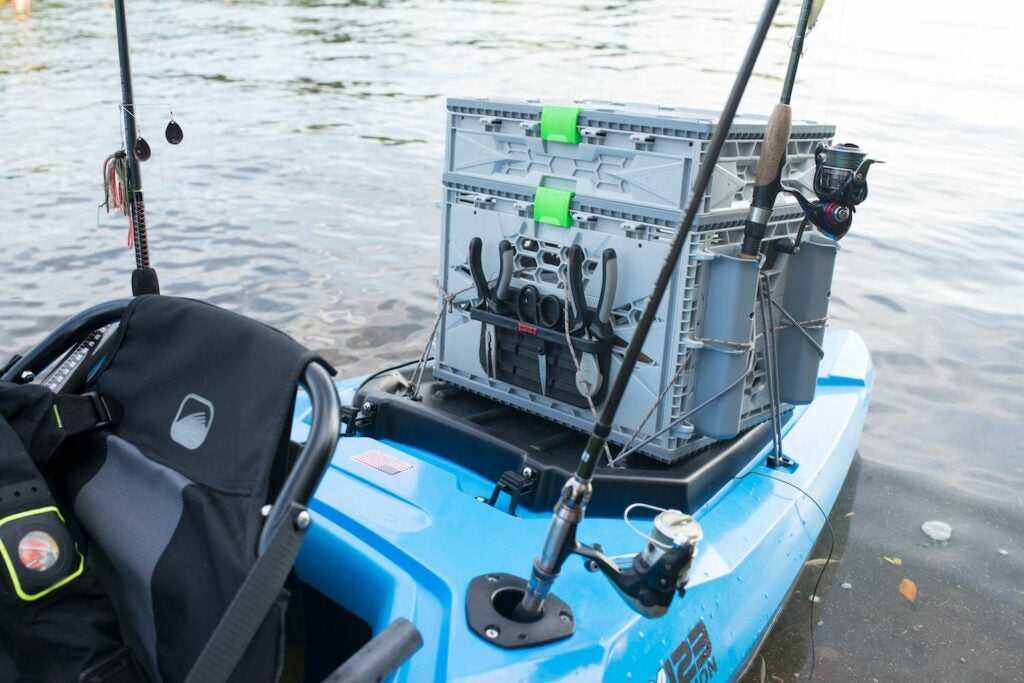
The Tuff Krate is ideal for a second reason: customization. As you can see in the photo above, I rigged the Rapala Magnetic Tool Holder to the front of the crate. The universal tie down ports accept many accessories that can keep your crate evolving, and it even features safety flag rings if you choose to fish in the salt. While rigging up at the launch, I used the lid as a work surface for rigging lures and tying leader, rather than balancing my tools on the surface of the kayak’s hull.
Tools are another important factor to consider when rigging your kayak. You don’t want your tools tangling in line or getting knocked into the water by a fish. That’s why I mounted the Rapala Magnetic Tool Holder behind me, on the front of the crate. Still within easy reach, the Tool Holder keeps a firm grip on the pliers, bolt cutters, and scissors so I know they’ll always be there. You don’t need all three tools all the time, and hopefully, you’ll never need to use the bolt cutters, but you should always carry them on your fishing kayak. If you ever get a hook in your hand, the bolt cutters can save your fingers and be the difference between a trip to the hospital and continuing to fish.

Bring Gear to Measure Your Fish on a Fishing Kayak
You’ve chosen the right fishing kayak and rigged up the essentials. Once you start catching fish, it’s time to size them up for proper bragging rights. A bump board has become the standard for all kayak bass fishing tournaments, and whether you choose to compete or not, they’re perfect for measuring fish quickly and accurately in your fishing kayak setup.
Many fishing kayak paddles, including the Bending Branches Angler Pro featured here, include a measuring tape on the paddle shaft. Those are perfect for quick measurements, such as gauging whether a fish is worthy of an actual measurement, but when you’re competing in a tournament and there are regulations you need to follow, you need a bump board. Plus, bump boards keep fish safer than letting them roll around in your lap or around inside your fishing kayak’s cockpit.
Bump boards like the YakGear Fish Stik help measure fish quickly, accurately, and safely. Ben Duchesney
The YakGear Fish Stik Bump Board folds up into a slim, easy-to-store package, and fits behind your kayak’s seat out of the way when you’re not measuring fish. Once you get your fish in the boat, pull the board out and unfold it across your lap or kayak’s deck. The Fish Stik can be unfolded easily with one hand or can lock into place fully extended and be stored at full length, ready to measure fish immediately. The YakGear Fish Stik comes with a black marker for marking the numbers on the bump board to make it easier for your camera to pick up the measurements of your fish. This is required if you’re going to compete in fishing kayak tournaments and makes it easier to measure your fish fast so you can get them revived and successfully released in no time.
Read Next: The Best Fishing Kayaks Under $1000 – Field & Stream
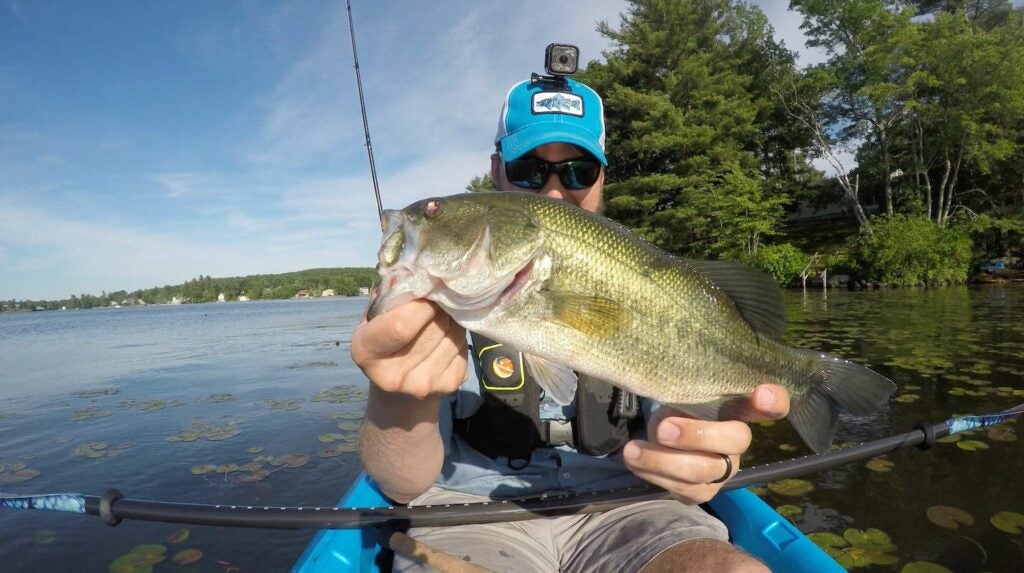
A Good Fishing Kayak Setup Helps You Catch More Fish
You can get on the water with a lot less gear than the items listed above, but you may decide that you need even more. The best part of rigging your fishing kayak yourself is that you can lay out the boat exactly the way you need it to suit your fishing style, your target species, and your local waters. For me, these are the essentials for kayak bass fishing, and each item either helped me hook up with more fish, or kept me safe while I was doing it.
Rigging up your fishing kayak setup is sometimes just as fun as fishing, so take your time and make sure to do it right. A few nights in the garage, blasting tunes and drinking a beer, are time well spent when the outcome is a perfectly laid out kayak bass-fishing machine.
Once you’re finished, get the fishing kayak on the water for a few shakedown runs to make sure everything is where it needs to be, and nothing is in your way. Testing your setup is important, so if you need more time than just two hours after work, it may be time for a day off.

